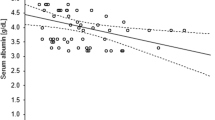Abstract
Introduction
High cut-off dialysis, increasingly used in multiple myeloma patients, is susceptible to influence anticancer drug elimination. We report about lenalidomide disposition in a patient on high cut-off dialysis for renal failure secondary to myeloma cast nephropathy.
Methods
The patient received a higher dosage of lenalidomide (5 mg b.i.d.), owing to concerns about a potential decrease in lenalidomide exposure during dialysis sessions. A set of blood samples was taken in order to develop a pharmacokinetic model accounting for lenalidomide concentrations in this setting.
Results
According to our model, the area under the curve was 3273 µg h/L, i.e., 60% higher than expected under usual dosage (25 mg q.d.) with normal renal function. Despite this, the patient did not develop major hematological toxicity.
Conclusions
Lenalidomide doses of 5 mg b.i.d. led to high exposure in a patient with renal failure undergoing high cut-off dialysis. Yet, the dosage of 5 mg q.d. recommended in conventional dialysis would probably be adequate in such patients.

Similar content being viewed by others
References
Celgene Corporation (2016) Product information REVLIMID® (lenalidomide) capsules. http://www.accessdata.fda.gov/drugsatfda_docs/label/2013/021880s034lbl.pdf. Accessed 28 Oct 2016
Chen N, Lau H, Kong L, Kumar G, Zeldis JB, Knight R, Laskin OL (2007) Pharmacokinetics of lenalidomide in subjects with various degrees of renal impairment and in subjects on hemodialysis. J Clin Pharmacol 47(12):1466–1475. doi:10.1177/0091270007309563
Tohnya TM, Hwang K, Lepper ER, Fine HA, Dahut WL, Venitz J, Sparreboom A, Figg WD (2004) Determination of CC-5013, an analogue of thalidomide, in human plasma by liquid chromatography-mass spectrometry. J Chromatogr B Anal Technol Biomed Life Sci 811(2):135–141. doi:10.1016/j.jchromb.2004.08.022
Hou J, Du X, Jin J, Cai Z, Chen F, Zhou DB, Yu L, Ke X, Li X, Wu D, Meng F, Ai H, Zhang J, Wortman-Vayn H, Chen N, Mei J, Wang J (2013) A multicenter, open-label, phase 2 study of lenalidomide plus low-dose dexamethasone in Chinese patients with relapsed/refractory multiple myeloma: the MM-021 trial. J Hematol Oncol 6:41. doi:10.1186/1756-8722-6-41
Chen N, Wen L, Lau H, Surapaneni S, Kumar G (2012) Pharmacokinetics, metabolism and excretion of [(14)C]-lenalidomide following oral administration in healthy male subjects. Cancer Chemother Pharmacol 69(3):789–797. doi:10.1007/s00280-011-1760-3
Hutchison CA, Heyne N, Airia P, Schindler R, Zickler D, Cook M, Cockwell P, Grima D (2012) Immunoglobulin free light chain levels and recovery from myeloma kidney on treatment with chemotherapy and high cut-off haemodialysis. Nephrol Dial Transplant 27(10):3823–3828. doi:10.1093/ndt/gfr773
Krieter DH, Devine E, Wanner C, Storr M, Krause B, Lemke HD (2014) Clearance of drugs for multiple myeloma therapy during in vitro high-cutoff hemodialysis. Artif Organs 38(10):888–893. doi:10.1111/aor.12248
Dimopoulos M, Alegre A, Stadtmauer EA, Goldschmidt H, Zonder JA, de Castro CM, Masliak Z, Reece D, Olesnyckyj M, Yu Z, Weber DM (2010) The efficacy and safety of lenalidomide plus dexamethasone in relapsed and/or refractory multiple myeloma patients with impaired renal function. Cancer 116(16):3807–3814. doi:10.1002/cncr.25139
Gandhi AK, Kang J, Havens CG, Conklin T, Ning Y, Wu L, Ito T, Ando H, Waldman MF, Thakurta A, Klippel A, Handa H, Daniel TO, Schafer PH, Chopra R (2014) Immunomodulatory agents lenalidomide and pomalidomide co-stimulate T cells by inducing degradation of T cell repressors Ikaros and Aiolos via modulation of the E3 ubiquitin ligase complex CRL4 (CRBN). Br J Haematol 164(6):811–821. doi:10.1111/bjh.12708
Author information
Authors and Affiliations
Corresponding author
Ethics declarations
Conflict of interest
All the authors declare that they have no conflict of interest.
Ethical approval
All procedures performed in studies involving human participants were in accordance with the ethical standards of the institutional and/or national research committee and with the 1964 Helsinki Declaration and its later amendments or comparable ethical standards.
Informed consent
Written and informed consent was obtained from the patient included in the study.
Electronic supplementary material
Below is the link to the electronic supplementary material.
Rights and permissions
About this article
Cite this article
Dao, K., Lu, Y., Peer, C.J. et al. Pharmacokinetics of lenalidomide during high cut-off dialysis in a patient with multiple myeloma and renal failure. Cancer Chemother Pharmacol 79, 215–218 (2017). https://doi.org/10.1007/s00280-016-3219-z
Received:
Accepted:
Published:
Issue Date:
DOI: https://doi.org/10.1007/s00280-016-3219-z




